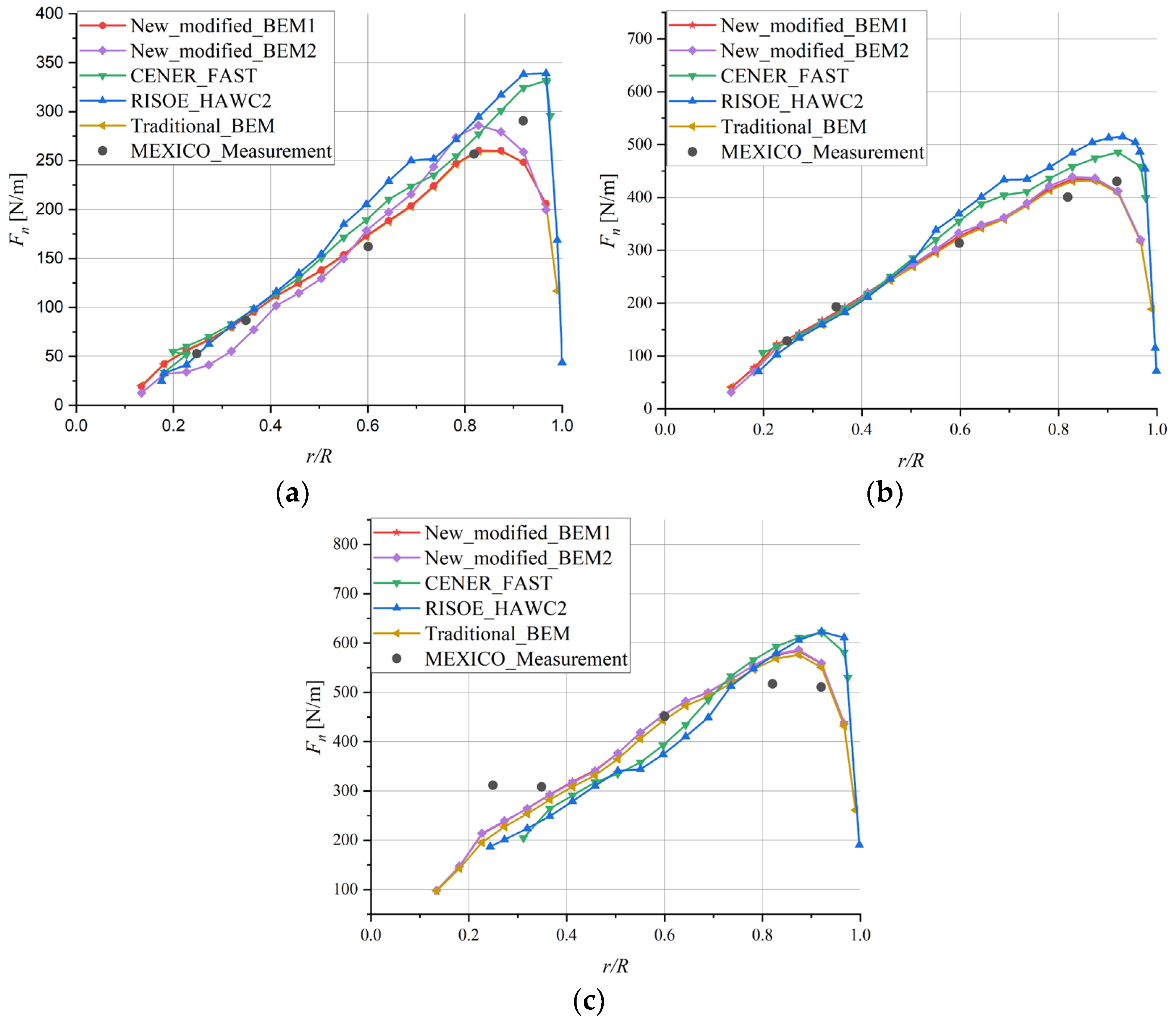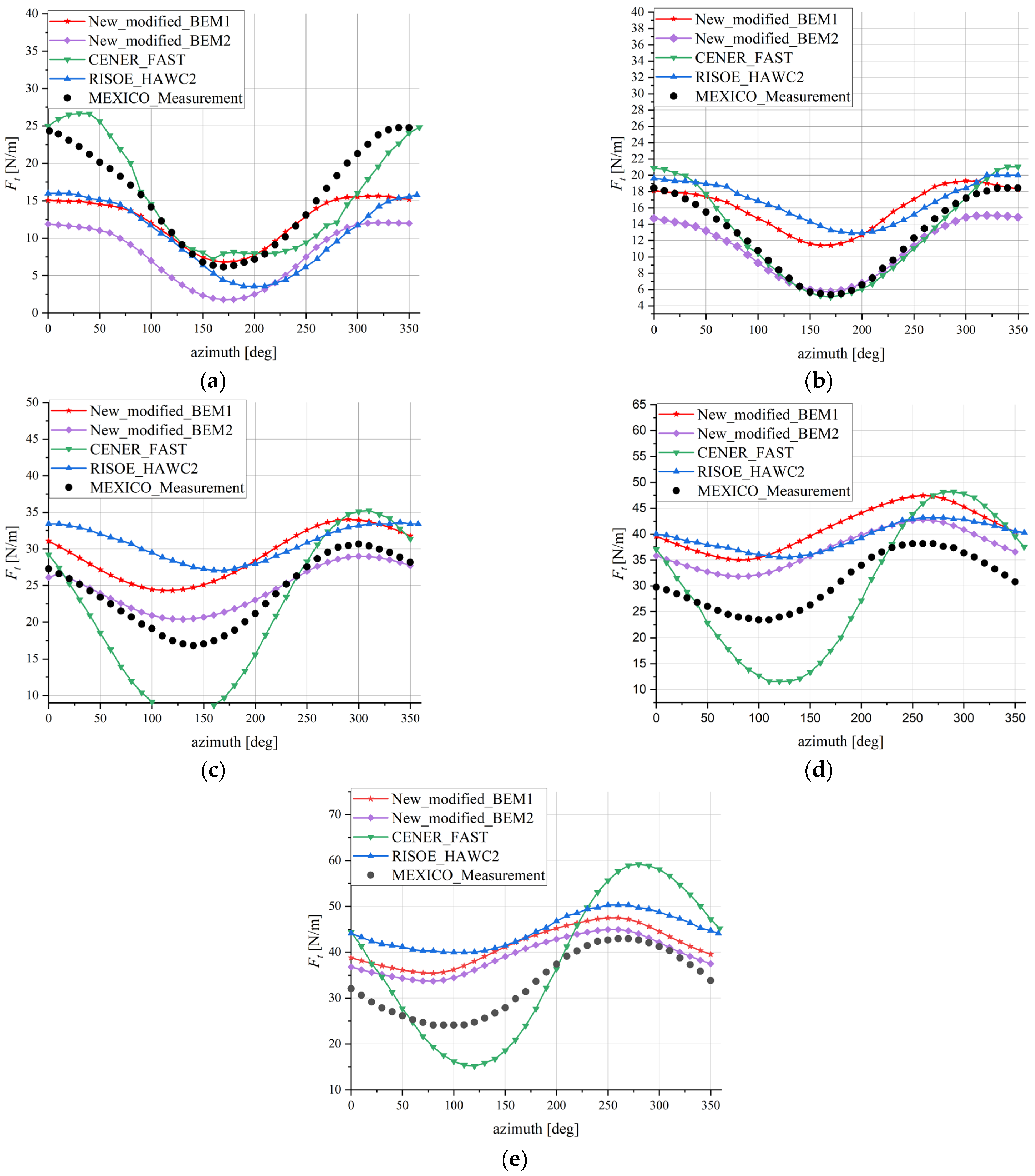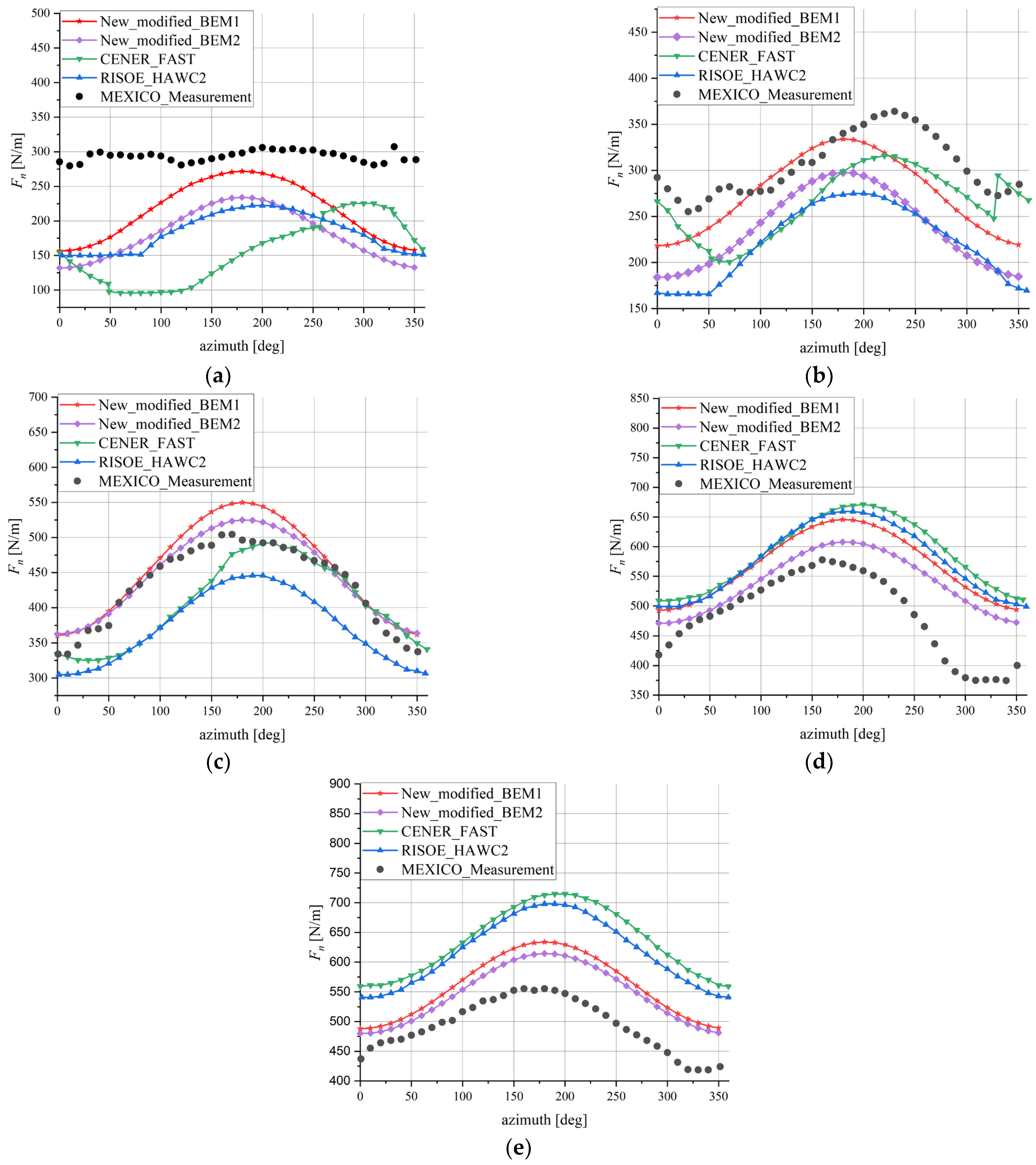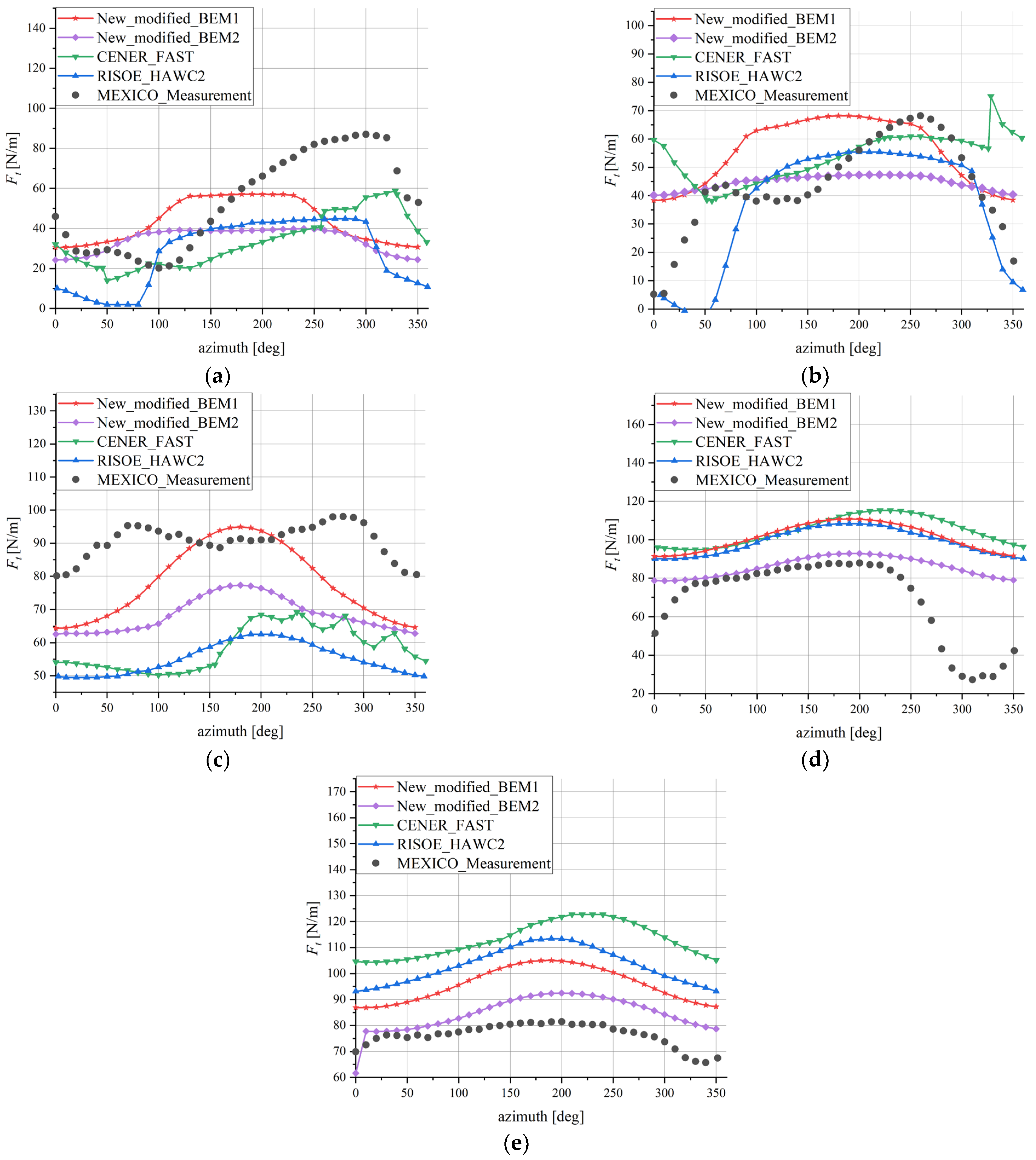A New Modified Blade Element Momentum Method for Calculating the Aerodynamic Performance of a Wind Turbine in Yaw
Abstract
1. Introduction
2. Numerical Methods
2.1. New Modified Blade Element Momentum Theory
2.2. Numerical Procedure
3. Results and Comparisons
3.1. MEXICO Rotor in Axial Flow Conditions
3.2. MEXICO Rotor at a Wind Speed of 15 m/s and a Yaw Angle of 30°
3.3. MEXICO Rotor at a Wind Speed of 24 m/s and a Yaw Angle of 15°
3.4. Limitations of the New Modified Model
4. Conclusions
Author Contributions
Funding
Data Availability Statement
Conflicts of Interest
References
- Wang, X.; Ye, Z.; Kang, S.; Hu, H. Investigations on the Unsteady Aerodynamic Characteristics of a Horizontal-Axis Wind Turbine during Dynamic Yaw Processes. Energies 2019, 12, 3124. [Google Scholar] [CrossRef]
- Rahimi, H.; Hartvelt, M.; Peinke, J.; Schepers, J.G. Investigation of the current yaw engineering models for simulation of wind turbines in BEM and comparison with CFD and experiment. J. Phys. Conf. Ser. 2016, 753, 022016. [Google Scholar] [CrossRef]
- Leishman, J.G. Challenges in Modeling the Unsteady Aerodynamics of Wind Turbines. Wind Energy 2002, 5, 85–132. [Google Scholar] [CrossRef]
- Snel, H.; Schepers, J.G.; Montgomerie, B. The MEXICO project (Model Experiments in Controlled Conditions): The database and first results of data processing and interpretation. J. Phys. Conf. Ser. 2007, 75, 012014. [Google Scholar] [CrossRef]
- Schepers, J.G.; Snel, H. Model Experiments in Controlled Conditions; Technical Report Number ECN-E-07-042; Energy Research Centre of The Netherlands (ECN): Petten, The Netherlands, 2007. [Google Scholar]
- Schepers, J.G.; Boorsma, K.; Cho, T.; Gomez-Iradi, S.; Schaffarczyk, P.; Jeromin, A.; Shen, W.Z.; Lutz, T.; Meister, K.; Stoevesandt, B. Analysis of Mexico Wind Tunnel Measurements: Final Report of IEA Task 29, Mexnext (Phase 1); Engineering, Environmental Science; Energy Research Centre of The Netherlands (ECN): Petten, The Netherlands, 2012. [Google Scholar]
- Ozbay, A. An experimental investigation on wind turbine aeromechanics and wake interferences among multiple wind turbines. Ph.D. Thesis, Iowa State University, Ames, IA, USA, 2014. [Google Scholar]
- Yu, D.O.; Kwon, O.J. Predicting wind turbine blade loads and aeroelastic response using a coupled CFD-CSD method. Renew. Energy 2014, 70, 183–196. [Google Scholar] [CrossRef]
- Qian, Y.; Zhang, Z.; Wang, T. Comparative Study of the Aerodynamic Performance of the New MEXICO Rotor under Yaw Conditions. Energies 2018, 11, 833. [Google Scholar] [CrossRef]
- Sorensen, J.N.; Shen, W.Z. Numerical modeling of wind turbine wakes. J. Fluids Eng. 2002, 124, 393–399. [Google Scholar] [CrossRef]
- Savino, A.; Ferreri, A.; Zanotti, A. Validation of a Mid-Fidelity Numerical Approach for Wind Turbine Aerodynamics Characterization. Energies 2024, 17, 1517. [Google Scholar] [CrossRef]
- Hansen, M. Aerodynamics of Wind Turbines; Earthscan: Routledge, UK, 2008. [Google Scholar]
- Wilson, R.E. Wilson, R.E. Applied Aerodynamics of Wind Power Machines; Oregon State University: Corvallis, OR, USA, 1974. [Google Scholar]
- Burton, T.; Sharpe, D.; Jenkins, N.; Bossanyi, E. Wind Energy Handbook; John Wiley and Sons Ltd.: West Sussex, UK, 2001. [Google Scholar]
- Gasch, R.; Twele, J. Wind Power Plants: Fundamentals, Design, Construction and Operation; Springer: Berlin/Heidelberg, Germany, 2011. [Google Scholar]
- Hansen, M.; Sørensen, J.; Voutsinas, S.; Sørensen, N.; Madsen, H. State of the art in wind turbine aerodynamics and aeroelasticity. Prog. Aerosp. Sci. 2006, 42, 285–330. [Google Scholar] [CrossRef]
- Hur, C.; Ferreira, C.; Schepers, G. Applicability of Dynamic Inflow Models of HAWT in Yawed Flow Conditions. Energies 2022, 15, 9368. [Google Scholar] [CrossRef]
- Schepers, J. Engineering models in wind energy aerodynamics. Ph.D. Thesis, Delft University of Technology, Deft, The Netherlands, 2012. [Google Scholar]
- Micallef, D. 3D flows near a HAWT rotor: A dissection of blade and wake contributions. Ph.D. Thesis, Delft University of Technology, Deft, The Netherlands, 2012. [Google Scholar]
- Liew, J.; Heck, K.S.; Howland, M.F. Unified momentum model for rotor aerodynamics across operating regimes. Nat. Commun. 2024, 15, 6658. [Google Scholar] [CrossRef] [PubMed]
- Garrel, A.V. Development of a Wind Turbine Aerodynamics Simulation Module; Technical Report Number ECN-C-03-079; Energy Research Centre of The Netherlands (ECN): Petten, The Netherlands, 2003. [Google Scholar]
- Jonkman, J.M.; Buhl, M.L. FAST User‘s Guide; National Renewable Energy Laboratory: Golden, CO, USA, 2005. [Google Scholar]
- Larsen, T.J.; Hansen, A.M. How 2 HAWC2, The User‘s Manual; Technical Report Number Risø-R-1597; ver. 3-1; Riso National Laboratory: Roskilde, Denmark, 2007; 70p. (In English) [Google Scholar]
- Moriarty, P.J.; Hansen, A.C. AeroDyn Theory Manual; NREL Technical Report Number TP-500-36881; National Renewable Energy Laboratory: Golden, CO, USA, 2005. [Google Scholar]
- Madsen, H.A. An analytical linear two-dimensional actuator disc model and comparisons with computational fluid dynamics (CFD) simulations. Wind Energy 2023, 8, 1853–1872. [Google Scholar] [CrossRef]
- Shen, W.Z.; Mikkelsen, R.; Sørensen, J.N.; Bak, C. Tip loss corrections for wind turbine computations. Wind Energy 2005, 8, 457–475. [Google Scholar] [CrossRef]
- Shen, W.Z.; Zhu, W.J.; Sørensen, J.N. Study of tip loss corrections using CFD rotor computations. J. Phys. Conf. Ser. 2014, 555, 012094. [Google Scholar] [CrossRef]
- Glauert, H. Airplane propellers. In Aerodynamic Theory; Durand, W.F., Ed.; Dover: New York, NY, USA, 1963; pp. 169–360. [Google Scholar]
- Spera, D.A. Wind Turbine Technology; Fairfield: New Jersey, NJ, USA, 1994. [Google Scholar]
- Madsen, H.A.; Bak, C.; Døssing, M.; Mikkelsen, R.F.; Øye, S. Validation and modification of the Blade Element Momentum theory based on comparisons with actuator disc simulations. Wind Energy 2010, 13, 373–389. [Google Scholar] [CrossRef]
- Nocedal, J.; Öztoprak, F.; Waltz, R.A. An interior point method for nonlinear programming with infeasibility detection capabilities. Optim. Methods Softw. 2014, 29, 837–854. [Google Scholar] [CrossRef]
- Wang, K. A study of cubic spline interpolation. InSight Rivier Acad. J. 2013, 9, 1–15. [Google Scholar]
- Coton, F.N.; Wang, T. The prediction of horizontal axis wind turbine performance in yawed flow using an unsteady prescribed wake model. Proc. Inst. Mech. Eng. Part A J. Power Energy 1999, 213, 33–43. [Google Scholar] [CrossRef]







| Yaw Angle | -Value |
|---|---|
| 1.10 | |
| 1.95 | |
| 1.30 |
| Parameters | Value | |
|---|---|---|
| Blade geometry | Rotor radius [m] | 2.25 |
| Hub radius [m] | 0.21 | |
| Experimental conditions | Rotational speed [rpm] | 424.5 |
| Pitch angle [degree] | −2.3 |
| Spanwise Position | New Modified BEM1 | New Modified BEM2 | HAWC2 | CENER FAST |
|---|---|---|---|---|
| 25% | 19% | 14% | 7% | 28% |
| 35% | 12% | 13% | 10% | 16% |
| 60% | 6% | 4% | 22% | 14% |
| 82% | 9% | 6% | 21% | 11% |
| 92% | 3% | 4% | 23% | 13% |
| Spanwise Position | New Modified BEM1 | New Modified BEM2 | HAWC2 | CENER FAST |
|---|---|---|---|---|
| 25% | 26% | 38% | 37% | 47% |
| 35% | 11% | 22% | 27% | 14% |
| 60% | 5% | 3% | 13% | 7% |
| 82% | 18% | 12% | 20% | 23% |
| 92% | 13% | 10% | 26% | 29% |
Disclaimer/Publisher’s Note: The statements, opinions and data contained in all publications are solely those of the individual author(s) and contributor(s) and not of MDPI and/or the editor(s). MDPI and/or the editor(s) disclaim responsibility for any injury to people or property resulting from any ideas, methods, instructions or products referred to in the content. |
© 2025 by the authors. Licensee MDPI, Basel, Switzerland. This article is an open access article distributed under the terms and conditions of the Creative Commons Attribution (CC BY) license (https://creativecommons.org/licenses/by/4.0/).
Share and Cite
Wu, J.; Sun, Z.; Zhu, W.; Fu, S.; Xu, C.; Shen, W. A New Modified Blade Element Momentum Method for Calculating the Aerodynamic Performance of a Wind Turbine in Yaw. Energies 2025, 18, 1063. https://doi.org/10.3390/en18051063
Wu J, Sun Z, Zhu W, Fu S, Xu C, Shen W. A New Modified Blade Element Momentum Method for Calculating the Aerodynamic Performance of a Wind Turbine in Yaw. Energies. 2025; 18(5):1063. https://doi.org/10.3390/en18051063
Chicago/Turabian StyleWu, Jiaying, Zhenye Sun, Weijun Zhu, Shifeng Fu, Chang Xu, and Wenzhong Shen. 2025. "A New Modified Blade Element Momentum Method for Calculating the Aerodynamic Performance of a Wind Turbine in Yaw" Energies 18, no. 5: 1063. https://doi.org/10.3390/en18051063
APA StyleWu, J., Sun, Z., Zhu, W., Fu, S., Xu, C., & Shen, W. (2025). A New Modified Blade Element Momentum Method for Calculating the Aerodynamic Performance of a Wind Turbine in Yaw. Energies, 18(5), 1063. https://doi.org/10.3390/en18051063








